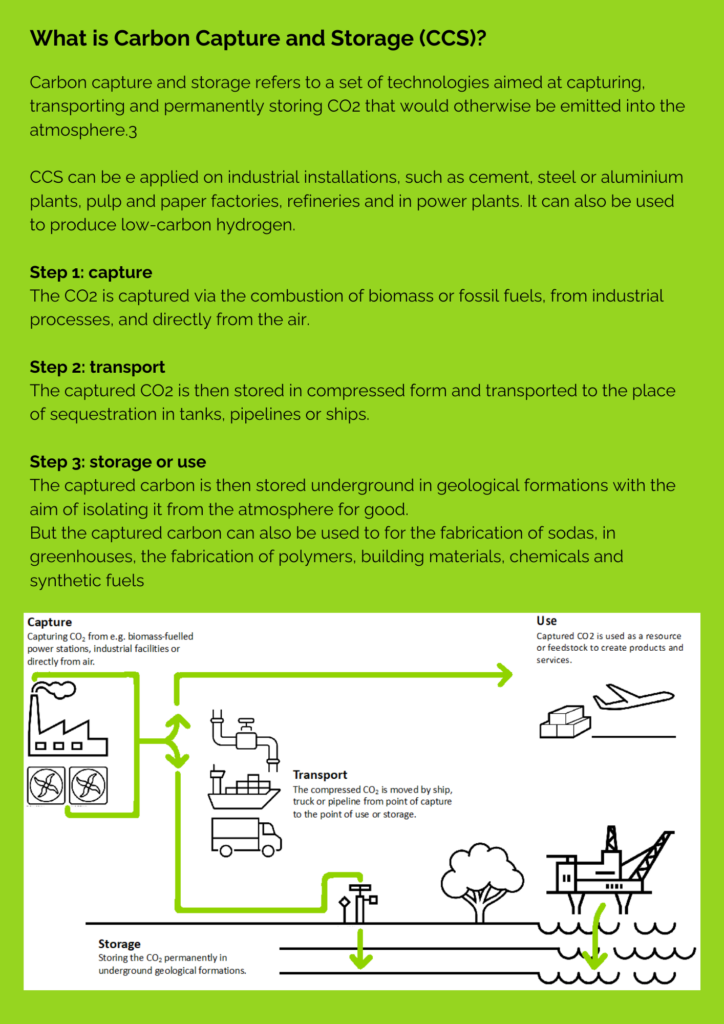Two days ago, the Commission presented its Strategy to boost Carbon Capture and Storage (CCS), thereby recognising the EU will have to sharply increase its use of the technology to reach climate neutrality by 2050. While CCS have existing for decades, their development has been slow, notably in the European Union.
Carbon capture and storage is essential to meet the EU’s climate targets
Experts agree, notably those of the Intergovernmental Panel on Climate Change, that CCS is crucial for achieving the EU’s 2050 climate targets because relying solely on renewable energies will not be sufficient. In 2021, the EU committed to achieving climate neutrality by 2050, aiming for zero net emissions. On 6th February 2024, the Commission unveiled its intermediate climate targets for 2040 and recommends a 90% reduction in net greenhouse gases emissions by 2040. The Commission acknowledged that an early deployment of carbon capture is necessary to achieve the 2040 targets.
Indeed, CCS will be especially useful to cut emissions from sectors like, steel, cement, chemical manufacturing, shipping and transport. These energy-hungry industries cannot decarbonize easily and rapidly and aren’t going away.
That’s why, alongside the Communication on climate targets, the Commission published its Strategy on Industrial Carbon Management which aims to boost carbon capture and storage. This Communication states that, to meet the EU’s 2040 climate targets, 280 million tonnes of CO2 would have to be captured by 2040 and around 450 million tonnes by 2050. These targets come in addition to that of the Net Zero Industry Act, that should be formally adopted before the European elections in June. The Net Zero Industry Acts, the EU has set up a target to store geologically 50 million tonnes of CO2 every year by 2030.
According to the Clean Air Taskforce, Europe has enough potential storage capacity to deal with projected rates of CO2 capture for at least 500 years and over two thirds of European countries have enough capacity to store at least 100 years of their own captured industrial emissions.
The Clean Air Taskforce found that the vast majority of European countries have good potential for CO2 storage, with only Estonia, Finland, and Luxembourg lacking suitable geology, and Belgium, Austria and Slovenia declaring very limited capacity.
Despite its potential to reach the EU climate goals and sufficient storage capacity, CCS technologies are not deployed vastly due to their high cost. The capture component, in particular, is an expensive part of the process.1 The cost of CCS should decrease once a certain number of large-scale demonstration plants are up and running and a functioning cross-border, open-access CO2 transport network is in place. For transport, the Commission estimates 7,300 km of infrastructure need to be build, requiring investments of over €12 billion by 2030, ramping to 19,000 km and €16 billion in 2040.
How the EU is supporting the take-up of carbon capture and storage
On the policy-side, as mentioned before, the EU just released its Industrial Carbon Management Strategy. The Strategy is mainly targeted at trapping emissions from energy-hungry industries like steel and cement, but it leaves it to Member States to decide in which sector to apply CCS at the national level.
In particular, the Strategy outlines several initiatives to support carbon capture and storage:
- The Commission will develop a platform for demand assessment and aggregation, with to match CO2 suppliers with storage operators.
- The Commission will create and make available an investment atlas of potential CO2 storage sites.
- The Commission will develop guidance for permitting processes for CCS net-zero strategic projects to facilitate final investment decisions and improve financial security for project promoters.
The Strategy complements other policies such as the EU Emissions Trading Scheme (ETS). CCS costs can be partly covered through the ETS: CO2 that is captured and safely stored is considered as “not emitted” under the ETS. However, currently, carbon utilisation is not included in the ETS.
Dating from 2009, the CCS Directive establishes a legal framework for the environmentally safe geological storage of CO2. It covers all CO2 storage in geological formations in the EU and the entire lifetime of storage sites.
On the funding side, several EU funds support CCS projects:
- The Innovation Fund: dedicates 25 billion EUR for breakthrough technologies in carbon capture, use and storage.
- The Connecting Europe Facility (CEF) supports cross-border CO2 transport networks.
- The Recovery and Resilience Facility (RRF) through investments in clean technologies and renewables, e.g. CCS.
- The Just Transition Fund (JTF) provides support to territories facing serious socio-economic challenges arising from the transition towards climate neutrality.
- Horizon Europe supports research, pilots and small-scale demonstration projects related to CCS.
- The Commission allows EU countries to support CCS through state aid.

The issue with the location of carbon storage sites
As mentioned before, the EU has enough storage capacity. However, there is one issue linked to storage sites in the EU: all existing storage sites are in the North Sea with Denmark and the Netherlands dominating the industry. Denmark alone could develop enough storage capacity to meet the EU’s goal to erect 50 million tons of CO2 storage by 2030.
This concentration of storage sites is problematic because it implies high cost for transporting the captured carbon for companies that are not located in this part of the continent. If carbon storage sites are not created evenly across the EU this would deepen geographical inequalities in the Union. The risk of deindustrialisation is particularity important for Southern, Central and Eastern European countries, where there are few CCS project developments happening, which will inevitably hurt the industrial competitiveness of these Member States.
According to the Clean Air Task Force, widespread development of individual storage sites by various countries would result in reduced costs due to the need for shorter, inland transport. In contrast to a scenario where storage sites are concentrated in the North Sea, the expenses associated with carbon transport would be three times lower.

The EU Commission is aware of this issue and is encouraging the development of carbon storage sites beyond the North Sea through provisions in the Net Zero Industry and funding programmes.
However, some obstacles at the national level are still to be overcome to spread storage sites evenly across the EU. Several countries currently have effective bans on CO2 storage (Germany, Austria, Latvia, Lithuania, Slovenia, and Finland) or incomplete regulatory frameworks, which make storage development challenging or impossible.
So now, what can companies do?
The Industrial Carbon Management Strategy, a non-legislative text, is a step in the right direction. But to achieve a widespread uptake of CCS technologies across the EU, much more needs to be done at the EU and national level, both on the regulatory and funding sides.
The Strategy is setting up the general framework for the scale-up of CCS in the EU. More concrete/specific/hands-on regulations, such as the revision of the ETS for carbon that is captured, stored or used remain to be developed. The different initiatives mentioned in the Strategy also must be implemented and the EU wide CO2 transport infrastructure needs to be built. All this cannot be done without the help of companies, who have the needs but also the expertise to capture, transport and store carbon.
Another key point is that the EU elections are taking place between 6th and 9th June. This will change the composition of the Parliament but also of high-ranking officials of the Commission. Companies must ensure that CCS will remain a priority of EU-policy makers after the elections. This requires a long-term endeavour to meet the relevant people and get your messages across.
Finally, as we have seen before, the EU has a role to play but so do Member States. Advocacy at the national level is also necessary and can be achieved through meetings at the Permanent Representations to the EU in Brussels, national Ministries or MEPs from the country in question, which is something Lykke Advice can help you with. Our consultancy specialises in helping SMEs with EU public affairs. We work to ensure that SMEs’ voices and expertise are heard by policy makers. If your company is involved in or interested in making CCS technologies a reality, don’t hesitate to contact us.


